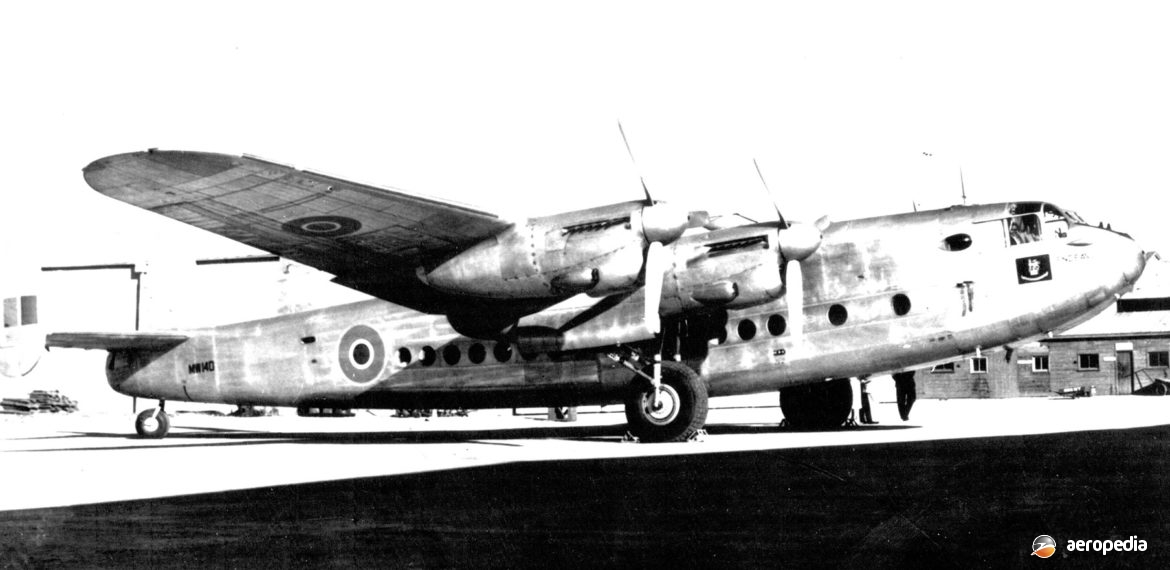Photograph:
Avro York MW140 at RAAF Fairbairn , ACT circa 1945 (RAAF museum)
Country of origin:
United Kingdom
Description:
Long-range military and commercial transport
Power Plant:
Four 1,209 kw (1,620 hp) Rolls Royce Merlin 502 twelve-cylinder VEE liquid-cooled engines
Specifications:
- Wingspan: 31.08 m (102 ft)
- Length: 23.94 m (78 ft 6 in)
- Height: 5.05 m (16 ft 6 in)
- Wing area: 111.94 m² (1,205 sq ft)
- Max speed: 480 km/h (298 mph)
- Cruising speed: 375 km/h (233 mph)
- Initial rate of climb: 457 m/min (1,500 ft/min)
- Ceiling: 7,925 m (26,000 ft)
- Range: 4,345 m (2,700 miles)
- Empty weight: 19,069 kg (42,040 lb)
- Loaded weight: 30,845 kg (68,000 lb)
History:
In 1941 Chief Designer for Avro, Roy Chadwick, commenced preparing drawings for a long-range transport aircraft based on the Avro Lancaster, culminating in the Avro 685 York. The prototype (KV626) flew for the first time on 5 July 1942. The York used a number of Lancaster assemblies, ie the mainplane, engines and empennage. A third fin was added, full production beginning in 1945 and concluding in April 1948. The York carried freight in a forward compartment, and had seating for 12 in a rear compartment. Total production was 256 aircraft. All Yorks but one were Mk Is with Merlin engines, the sole Mk II (LV626) being fitted with four Bristol Hercules engines.
A number were delivered to RAF Transport Command, and occasionally these were noted as visitors to this region. One (LV633) was fitted out as a VIP aircraft for Sir Winston Churchill, being used as a flying conference room and was used to take the British Prime Minister and Allied commanders to Algiers in May 1943. Later it flew King George VI on a tour of troops in North Africa and the Mediterranean.
Five were delivered to the Argentinian airline FAMA in 1946, and these were configured for 24 passengers.
A number were operated by civil operators in the United Kingdom and Canada. They operated on regular passenger services, and the British Overseas Airways Corporation (BOAC) fleet of aircraft was used to replace flying boats on the old routes previously operated by the Short C-Class aircraft.
At the time the Yorks were withdrawn from service they had flown 70,811,136 km (44 million miles) in 226,996 hours and carried 90,000 passengers. British operators included Skyways (30), BSAA (19) and BOAC (30). They saw extensive service during the Berlin Airlift, flying 58,124 missions.
Probably the first to be seen in this region was MW102, the third production aircraft, which was modified by the installation of a long-range fuel tank and an Avro Lincoln type undercarriage. It was sent to New Delhi to establish max-weight take-off figures for the type in September 1944, later going to Ceylon and flying on to Exmouth Gulf, WA, arriving on the 21st of that month in a time of 14 hrs 5 mins at an average speed of 354 km/h (220 mph). This aircraft was painted white overall.
On 9 November 1944 Sir Fergus McMaster at the Annual General Meeting of Qantas announced the company was ordering “a number of Avro York aircraft, the semi-commercial version of the Lancaster bomber”. He said the commercial cruising speed of the York was 322 km/h to 354 km/h (200 mph to 220 mph) and it would carry 30 to 32 passengers seated or 20 when configured for sleeping accommodation. In fact no Yorks were acquired and Qantas after World War II operated Avro Lancastrians before it introduced the American-built Lockheed Constellation.
One example was based in Australia for some years. This aircraft, the 41st production aircraft (MW140), was stock standard, was initially camouflaged, and was delivered to the RAAF for use by the Governor General of Australia, the Duke of Gloucester. The aircraft was flown and maintained by the RAAF at Fairbairn, ACT. Flown from the UK in April 1945, and allotted the RAAF identification A74-1 (which was never carried), it was attached to the Canberra Commonwealth Flight and named ‘Endeavour’. For the flight to Australia it was fitted with a 2,937 litre (624 Imp gal) fuel tank in the fuselage. It differed from other Yorks in having the elevators and ailerons metal covered.
This aircraft was fitted out as a VIP aircraft, the crew’s quarters being expanded. The fuselage was divided into a forward stateroom, separated from the main saloon by a galley, and a rear stateroom with private bathroom facilities. By the time it entered service it was polished metal overall and had the name ‘Endeavour’ and the Australian Coat of Arms in gold and crimson on a royal blue background on the nose. It was used for a number of long-range flights, including the Duke of Gloucester’s tour of New Guinea, New Britain and Bougainville in 1945. It was also used to evacuate ex-POWs from Singapore. On 17 January 1947 ‘Endeavour’ left for the United Kingdom and was returned to the British Air Ministry.
In addition to the RAF and BOAC Yorks, which regularly visited this region, one (MW102), which had been converted to VIP use and was the personal aircraft of the Commander in Chief Far East Royal AirForce, Lord Louis Mountbatten, was used by him when making a tour of Australia in March 1946.
Other Yorks visited this part of the world, including G-AHFH of British South American Airways, which visited New Zealand in 1947.
Two examples survive, York C.1 G-AGNV (TS798 – c/n 1223) at the RAF Museum at Cosford in Shropshire and York C.1 G-ANTK (ex MW232), which operated in the Berlin Airlift, at the Imperial War Museum at Duxford in Cambridgeshire.
.

